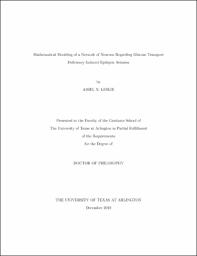
ATTENTION: The works hosted here are being migrated to a new repository that will consolidate resources, improve discoverability, and better show UTA's research impact on the global community. We will update authors as the migration progresses. Please see MavMatrix for more information.
Show simple item record
| dc.contributor.advisor | Su, Jianzhong | |
| dc.creator | Leslie, Ariel N | |
| dc.date.accessioned | 2021-01-12T17:21:23Z | |
| dc.date.available | 2021-01-12T17:21:23Z | |
| dc.date.created | 2019-12 | |
| dc.date.issued | 2019-11-21 | |
| dc.date.submitted | December 2019 | |
| dc.identifier.uri | http://hdl.handle.net/10106/29666 | |
| dc.description.abstract | Epilepsy is a complex phenomena of a system of neurons simultaneously firing that are highly intensive and synchronized. Seizures are a common and well known physical feature for all types of epileptic disorders [8]. Epilepsy is known to be traced back to spatial and temporal patterns working in sequence. The rhythms, patterns, and oscillatory dynamics explain the mechanistic nature of neurons especially in absence seizures [37]. An electroencephalogram device (EEG) monitors the electrical activity within the brain using small electrodes, which measures voltage fluctuations on the scalp. Previous models such as Wilson-Cowan (1972) [34], introduced a model showing the dynamics of a network of neurons consisting of excitatory and inhibitory neurons. Taylor et. al (2014) then adapted the Wilson-Cowan model to epileptic seizures using a thalamo-cortical based theory. Fan et. al (2018) projects that thalamic reticulus nuclei control spike wave discharges specifically in absence seizures.G1D Transport Deficiency Epilepsy can be identified by the high number of seizures during the infant stage which is usually rapid, irregular eye movement, and small brain size. We want to identify brain activity specific to G1D by using EEG data. Additionally, we want to study the EEG patterns to identify the plausible mechanism that causes G1D epileptic behavior. The goal is to find out how an entirely connected brain network shows the neuronal functionality as a unit regarding G1D. Our coupled thalamo-cortical model goes beyond a connection in a logical unidirectional pattern shown by Fan (2018) or in a bidirectional small world pattern. Our model is a network based on paired correlation of EEG signals more analogous to realistic seizure activity. Using our model, we are able to study stability analysis for equilibrium and periodic behavior, parameter values which cause synchronized activity or more stable activity and identify a synchronization index, and sensitivity analysis regarding parameters that directly affect Spike Wave Discharges and other spiking behavior. We will show how our 32-unit network model reflects G1D seizure dynamics and discuss the limitations of the model. | |
| dc.format.mimetype | application/pdf | |
| dc.language.iso | en_US | |
| dc.subject | Glucose transport deficiency type 1 | |
| dc.subject | Seizure | |
| dc.subject | Thalamus | |
| dc.subject | Cortex | |
| dc.subject | Absence seizures | |
| dc.title | Mathematical Modeling of a Network of Neurons Regarding Glucose Transport Deficiency Induced Epileptic Seizures | |
| dc.type | Thesis | |
| dc.degree.department | Mathematics | |
| dc.degree.name | Doctor of Philosophy in Mathematics | |
| dc.date.updated | 2021-01-12T17:21:23Z | |
| thesis.degree.department | Mathematics | |
| thesis.degree.grantor | The University of Texas at Arlington | |
| thesis.degree.level | Doctoral | |
| thesis.degree.name | Doctor of Philosophy in Mathematics | |
| dc.type.material | text | |
Files in this item
- Name:
- LESLIE-DISSERTATION-2019.pdf
- Size:
- 3.760Mb
- Format:
- PDF
This item appears in the following Collection(s)
Show simple item record


